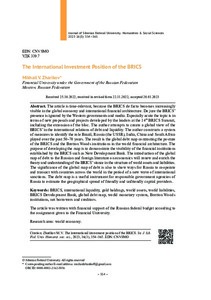Показать сокращенную информацию
The International Investment Position of the BRICS
| Автор | Zharikov, Mikhail V. | en |
| Автор | Жариков, М. В. | ru_RU |
| Дата внесения | 2023-03-12T09:04:21Z | |
| Дата, когда ресурс стал доступен | 2023-03-12T09:04:21Z | |
| Дата публикации | 2023-03 | |
| URI (для ссылок/цитирований) | https://elib.sfu-kras.ru/handle/2311/149946 | |
| Аннотация | The article is time-relevant, because the BRICS de facto becomes increasingly visible in the global economy and international financial architecture. De jure the BRICS’ presence is ignored by the Western governments and media. Especially acute the topic is in terms of new proposals and projects developed by the leaders at the 14th BRICS Summit, including the extension of the bloc. The author attempts to create a global view of the BRICS’ in the international relations of debt and liquidity. The author constructs a system of measures to identify the role Brazil, Russia (the USSR), India, China and South Africa played over the past 50–70 years. The result is the global debt map contrasting the posture of the BRICS and the Bretton Woods institutions in the world financial architecture. The purpose of developing the map is to demonstrate the visibility of the financial institutions established by the BRICS such as New Development Bank. The introduction of the global map of debt to the Russian and foreign literature on economics will renew and enrich the theory and understanding of the BRICS’ stance in the structure of world assets and liabilities. The significance of the global map of debt is also to show ways for Russia to cooperate and transact with countries across the world in the period of a new wave of international sanctions. The debt map is a useful instrument for responsible government agencies of Russia to estimate the geographical spread of friendly and unfriendly capital providers | en |
| Аннотация | Статья носит актуальный характер, поскольку страны БРИКС наращивают свое присутствие в глобальной экономике и международной финансовой архитектуре по факту. Вместе с тем эта тема мало обсуждается, особенно в документах западных стран и СМИ. Острота актуальности темы проявляется и в анализе предложений и проектов, разработанных лидерами стран на 14-м саммите БРИКС, включая расширение блока. Автор предпринимает попытку представить глобальное видение стран БРИКС в международных долговых отношениях и ликвидности, а также строит систему показателей для определения места и роли Бразилии, России (СССР), Индии, Китая и ЮАР за последние 50–70 лет. В результате создана глобальная карта долга, позволяющая сопоставить положение стран БРИКС и Бреттон-Вудских институтов в мировой финансовой архитектуре. Целью разработки этой карты является демонстрация фактического присутствия финансовых институтов, учрежденных при форуме БРИКС, включая Банк развития БРИКС. Введение глобальной карты долга в российскую и зарубежную литературу позволит пересмотреть и обогатить теорию и понимание роли стран БРИКС в структуре мировых активов и обязательств. Значимость глобальной карты долга заключается в том, чтобы показать подходы сотрудничества России и расчетов со странами мира в период усиления волны международных санкций. Карта долга – эффективный инструмент для соответствующих органов власти, в частности России, при оценке потенциала и географии дружественных и недружественных доноров капитала | ru_RU |
| Язык | en | en |
| Издатель | Сибирский федеральный университет. Siberian Federal University | en |
| Тема | BRICS | en |
| Тема | international liquidity | en |
| Тема | gold holdings | en |
| Тема | world assets | en |
| Тема | world liabilities | en |
| Тема | BRICS Development Bank | en |
| Тема | global debt map | en |
| Тема | world monetary system | en |
| Тема | Bretton Woods institutions | en |
| Тема | net borrowers and creditors | en |
| Тема | страны БРИКС | ru_RU |
| Тема | международная ликвидность | ru_RU |
| Тема | золотой запас | ru_RU |
| Тема | мировые активы | ru_RU |
| Тема | мировые обязательства | ru_RU |
| Тема | Банк развития БРИКС | ru_RU |
| Тема | глобальная карта долга | ru_RU |
| Тема | мировая валютная система | ru_RU |
| Тема | Бреттон-Вудские институты | ru_RU |
| Тема | чистые заемщики и кредиторы | ru_RU |
| Название | The International Investment Position of the BRICS | ru_RU |
| Альтернативное название | Международная инвестиционная позиция стран БРИКС | ru_RU |
| Тип | Journal Article | en |
| Контакты автора | Zharikov, Mikhail V.: Financial University under the Government of the Russian Federation Moscow, Russian Federation; michaelzharikoff@gmail.com; ORCID: 0000-0002-2162-5056 | en |
| Контакты автора | Жариков, М. В.: Финансовый университет при Правительстве Российской Федерации Российская Федерация, Москва | ru_RU |
| Страницы | 354–365 | ru_RU |
| Журнал | Журнал Сибирского федерального университета. Гуманитарные науки. Journal of Siberian Federal University. Humanities & Social Sciences; 2023 16 (3) | en |
| EDN | CNVSMO |

